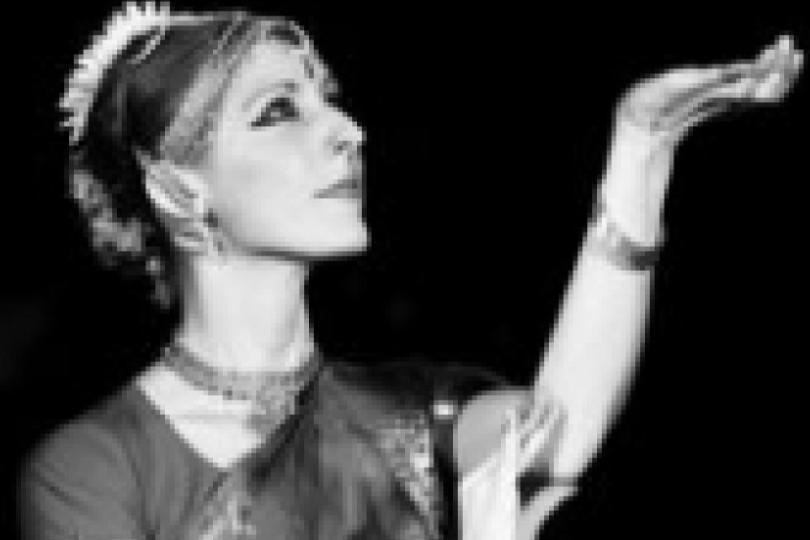How might one approach Bharatanatyam? There are multiple ways “in,” such as responding to what appears on-stage, investigating the dance form’s history and how its style compares with that of other forms, and learning about the technique that serves as the dance’s foundation. Each way in provides a partial view, a unique perspective on this multifaceted form.
Performance
There is the power of a dancer creating driving rhythms with feet, as arms deftly curve and cut through space. There is joy in leaping, legs tucked under body, arm piercing space with fingers splayed. There is the subtly of the soloist who, through the slow lift of the eyes or tilt of the head, and through gestures ever so discrete, commands your attention and pulls at your heart. There is energy—controlled and deployed—that issues from eyes and limbs, creating vast trajectories stretching beyond the immediate space occupied by the body.
History
Bharatanatyam originated in the Tamil Nadu region of Southern India and has antecedents that can be traced back 2,000 years. Dance flourished under temple and royal patronage, advanced by the work of devadasis, a class of dancers affiliated with Hindu temples whose lives were dedicated to refining and performing dances known as Dasi Attam or Sadir. Under British colonization, the devadasis lost their support system, but struggled to maintain the dance form. In the 1930s, the dance of the devadasis was renamed Bharatanataym and rose to acclaim amid upper-class nationalist reinvestment in classical art forms. Soloists and companies around the world now perform Bharatanataym by drawing from the classical technique to create new choreographies.
In comparison
Bharatanatyam is one of numerous Indian classical dance forms. Viewers can discern general similarities, such as rhythmic foot patterns and intricate hand gestures, but each form remains distinct. The upright stance and fast turns of Kathak, or the isolated body bends found in Odissi, distinguish these techniques from Bharatanatyam. Local companies such as Ragamala Dance (Bharatanatayam), Katha Dance Theatre (Kathak), and Ananya Dance Theatre (Odissi and other movement vocabularies) reflect not only the range of classical Indian dance, but also the diversity of contemporary interpretations and innovations.
Technique, expressive and abstract
Bharatanatyam’s movement vocabulary is notable for its precision, clarity of line and rhythm, and expressive distinctions between incisiveness and grace. Honed through years of intense training, this technique is composed of two intertwined aspects: nritta (pure or abstract dance) and abhinaya (expressive dance). The word “Bharatanatyam” reflects these components. The Sanskrit word bhava means “expression,” raga means “melody,” tala is “rhythm,” and natyam is “dance.”
Musicality is emphasized in the name “Bharatanatyam” and through nritta becomes visible on stage. Complex rhythms course through the music and choreography as the dancer paints the music in space. Through abhinaya’s stylized mime the hands, face and body are used to depict characters, settings, concepts and narratives. In its expressive aspect, Bharatanatyam conveys meaning kinetically. Effusive joy, wrenching sorrow, cruel injustice and devotional awe are communicated through the body in Bharatanatyam, and represented in their grandeur and minutiae through a dancer’s subtle articulations.
Watching Bharatanatyam
Classical versus fusion: Bharatanatyam can be presented in its classical form or blended with other movement styles. Taking note of the choreographer’s descriptions in program notes can help you know how the technique will be used in that specific performance.
Pure dance and storytelling: Nritta and abhinaya can be emphasized separately or interspersed within one piece. Try to discern which aspect you are seeing.
Artistic agency: Bharatanatyam is a living art form with a range of styles and an infinite array of ways to use the technique. Enjoy choreographic decisions regarding the navigation of bodies, musicality, contrasts and nuances. Take note of the unique interpretations that each dancer brings to a performance.
Delve deeper: Bharatanatyam is a fascinating art form with a long, complex history and diverse contemporary manifestations. Being aware of this variety can be both daunting and inspiring. Do not seek to “get” each moment, but rather acknowledge that the experience of dance takes place through time and will resonate with you afterward.
Jessica Fiala
Jessica Fiala has been a member of the Minneapolis-based Ragamala Dance since 2006, and has toured nationally and internationally with the company. She volunteers with the Walker Art Center’s SpeakEasy post-performance discussion program and works at the Alliance Française. She received her Master of Liberal Studies degree from the University of Minnesota in 2008, with a focus on museum and cultural studies.



